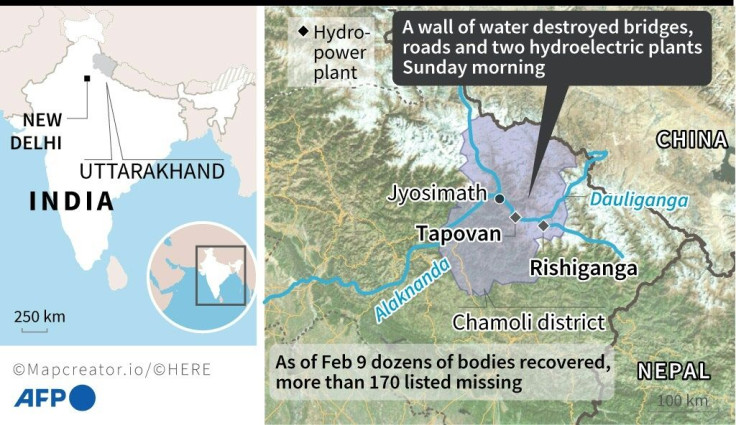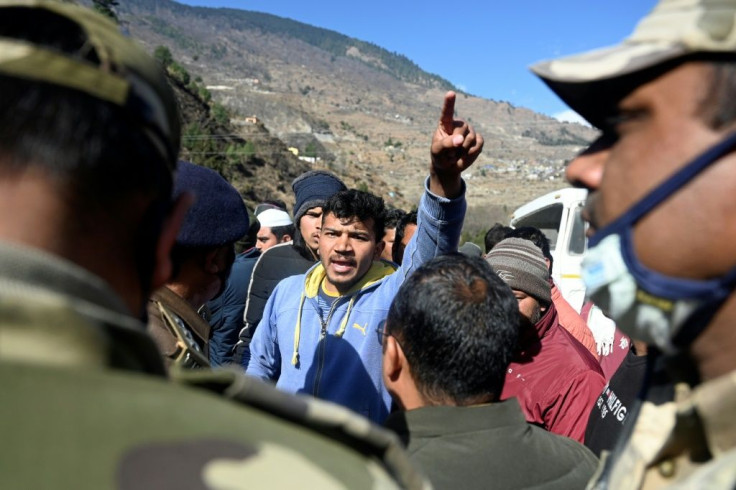Anger As Hopes Fade For Indian Workers After Glacier Disaster
Dozens of angry and desperate relatives of about 30 people trapped in a tunnel since a glacier disaster in India jostled with police on Wednesday as hopes faded that they would be found alive.
More than 170 people were still missing after a barrage of water and debris hurtled down a valley with terrifying speed and power on Sunday morning, sweeping away bridges and roads and hitting two hydroelectric plants.
Thirty-two bodies have been found so far, officials said on Wednesday. It may take days for more bodies to be recovered from under the tonnes of rocks and other debris and a thick soup of grey mud.
The main focus of the massive rescue operation, under way day and night since Sunday, is a tunnel near a severely damaged hydroelectric plant that was under construction at Tapovan in Uttarakhand state.

Workers there have been battling through hundreds of tonnes of sludge, boulders and other obstacles to try and reach between 25 and 35 people who rescuers hope are still alive in air pockets.
"As time passes, the chances of finding them are reducing. But miracles do happen," Piyoosh Rautela, a senior state disaster relief official, told AFP.
"Man, machinery, we are all working round the clock. But the amount of debris is so much that it's going to take a while to remove all that," he said.

Outside there were medical teams on standby with oxygen cylinders and stretchers, as well as increasingly desperate and enraged relatives.
There have been no signs that their loved ones are still alive.
"This entire rescue operation is a joke," Sanjay Pant, whose 24-year-old electrical engineer brother Abhishek was in the tunnel, told AFP.

"We are not living in the 18th century where just one bulldozer can be used to clear tonnes of slush. Where is our technology, where are our machines?"
"Authorities are not showing any urgency to rescue those trapped. Another day and we will have to give up hope," said Santosh Yadav, whose brother-in-law Sanjay was also in the tunnel.
"They cannot survive too long in the tunnel even if they are alive now. There is no air, water or food inside and it is freezing cold inside the tunnel. Only God can save them."
Sandeep Nautiyal, one of the bulldozer drivers trying to dig their way to the missing men, said the task was extremely challenging.
"The more we remove the slush, the more appears. Every corner of the tunnel is filled with rocks, slush and debris," he told AFP.
"We can only hope that they have found a corner inside the tunnel to survive. But that seems unlikely."
In Rome, Pope Francis said on Wednesday he was "praying for the missing workers, for their families and for all the injured and those who have suffered losses."
Twenty-five of the bodies recovered so far were yet to be identified. Many of the victims are poor workers from other parts of India hundreds of miles away.
The cause of the disaster is thought to have been a chunk of glacier breaking off.
Glaciers have been melting rapidly in the Himalayan region because of global warming, and experts predict similar catastrophes in the future.
Building activity for dams, the dredging of riverbeds for sand and the clearing of forests for new roads -- some to beef up defence on the Chinese border, others for Hindu pilgrims -- are other factors.
© Copyright AFP 2024. All rights reserved.




















